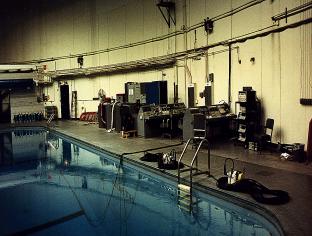
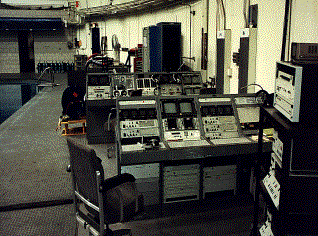
by
Larry "Harris" Taylor, Ph.D.
This is an electronic reprint and expansion of an article that appeared In Discover
Diving, (October, 1992, p.12-13). This material (minus NASA photos) is
copyrighted and all rights retained by the author. This article is made
available as a service to the diving community by the author and may be
distributed for any non-commercial or Not-For-Profit use.
All rights reserved.
Go To: Home About "Harris" Articles Slides War Stories Editorials Links Fini
After this article appeared, NASA built a much larger facility, the Neutral Buoyancy Lab.
The only thing larger than this
new pool is the dedication of the astronauts and their diver support
team.
"One small step for man; one giant step for mankind" are words that will
live forever in the hearts and souls of humanity. Before uttering these historic
words, astronaut Neil Armstrong, along with a supporting cast of thousands,
spent seemingly infinite hours of practice to ensure a safe and successful lunar
operation.
The key to any successful operation is practice. The better the practice
in anticipating the reality of a working predicament, the better the task will
ultimately be done. The astronauts work in the near zero vacuum and zero gravity
outside earth's atmosphere. Not
only must their fragile humanity be protected by bulky environmental suits that
isolate the astronaut from the task at hand, but they must learn to function
within these suits to perform useful tasks. In space, work tasks that appear
trivial on earth, take on a new challenge, as the tasks must be completed
without the aid of gravity. Accomplishing useful labor requires special tools
and much practice. NASA appears to live by the adage that perfect performance is
only derived from lots of perfect practice.
The weightlessness of outer space is best simulated on earth in a water
environment. We cannot, of course, eliminate the forces of gravity. We can,
however, counter the weight of an object in the water by applying a buoyant
force. Likewise, floats can be attached to objects denser than water. This
application of an equal opposing force provides an illusion of working in a
weightlessness environment. This environment allows astronauts to develop
appropriate work skills on earth before attempting a project in the weightless
vacuum of their orbital working environment.
The Weightless Environmental Training Facility (WETF) is housed in
building 29 of the Lyndon Johnson Space Center in Houston, Texas. Its purpose is
to provide a weightless training environment for the corps of astronauts who
will operate in space. This essential facility allows engineers and designers an
opportunity to develop spacecraft equipment, to evaluate tools and procedures
that allow people to function in space and to safely evaluate human capabilities
and workload capacities within the constraints of the environmental protection
systems and specialized tools they are using.


Astronaut Support/Monitor Consoles
Close-Up of Consoles
The actual training now occurs in a 78' x 33' swimming pool that is 25
feet deep. The pool itself appears no different from any other swimming pool. It
is filled with water and reeks of chlorine. The surroundings, however, rapidly
inform the visitor that this is no ordinary swimming pool. Above the pool are
two pneumatic cranes, each capable of lifting more than 5 tons. These devices
move full-scale space shuttle and other payload mock-ups designed for work in
outer space into the pool. On one side of the pool is a storage area for a vast
assortment of these full-scale models. The current pool is not large enough for
a complete full-size spacecraft so that astronauts must practice on only the
payload bay area. The pool now being used is also too small for practice on the
assembly of the planned international joint-venture space station. A planned
future facility will be large enough to house complete shuttle and space station
mock-ups. Different training missions require different models and the cranes
move the relevant mock-ups into and out of the pool. In addition, there are two
distinct monitoring stations. The first series of monitoring instrumentation
monitors the physiological status of each of the up to two astronauts in the
pool during a training mission. NASA policy mandates that physicians with
expertise in aerospace medicine be available during all training activities. A
second series of monitors continuously evaluates the environmental suits that
the astronauts use and the total status of the training mission. The entire pool is under constant video
camera surveillance. The divers will tell you that everything that occurs in the
pool during a training mission is being observed topside. Next to this
monitoring station is all the plumbing necessary to furnish breathing air and
cooling water to the astronaut's environmental suits. Of course, also present is
complete back up of all systems.
Lastly, there is a complete diving locker equipped with compressor and
storage cylinders to support the dive team of more than 30 divers.
The WETF dive support team is a unique group of divers. They are not mere
sport divers. Each must maintain
superb physical fitness and operate at a high level of diving efficiency. Many
incoming sport divers must be retrained too much higher standards to operate
within WETF working guidelines. Much of the WETF diver's time is spent training
to ensure this continuous high level of performance. Each must be qualified in
astronaut in-pool rescue and must maintain this proficiency by actual
demonstration. This particular
rescue involves lifting a diver in a totally flooded environmental space suit
from the bottom of the pool to a position where life-support assistance is
possible. The exercise must be successfully completed in less than one minute.
(Note that moving a flooded space suit around the pool and lifting it 25 feet to
the surface is not an easy task.) But, these are not ordinary divers! They are responsible for the lives of
the astronauts during in-water training.
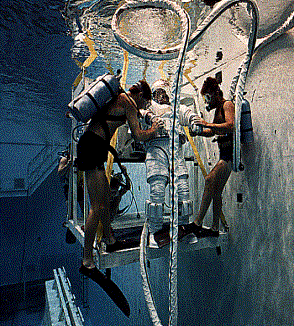
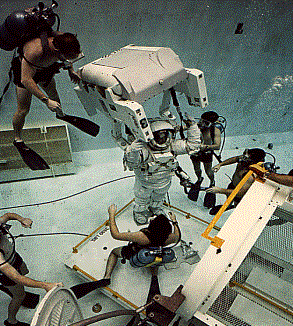
Astronaut rides elevator into training area
Note the ratio of divers / astronaut
Before a training session begins, the divers inspect the training
mock-ups and ensure that all necessary materials have been assembled and are
available to the astronauts. During the training mission, each astronaut is
assigned two divers. The training mission begins by insuring that the astronaut
and all his/her limbs are neutrally buoyant. This involves a rather elaborate
system of weights that are placed at various locations on the environmental
protection suit so that astronaut can be truly neutrally buoyant during
training. Of course, each astronaut is different physically so that each
astronaut's buoyancy must be individually fine-tuned for each training mission.
The goal is such that no matter what orientation the astronaut trainee assumes
in the pool, neither gravity nor suit buoyancy will control movement. Throughout
the training mission the divers, as well as the topside crew, monitor the
astronaut. In the unlikely event of a system failure, the divers must
instantaneously respond to pull the astronaut out of the water. After the
training mission is over, the divers must re-configure the pool and ensure that
all training mock-ups are ready for the next training mission.


Astronauts practice single and team tasks on full size mockups
Occasionally, completely new space suit designs are tested in the pool
and divers will do some of the actual testing. I suspect that diving in a space
suit probably fulfils the ultimate fantasy of everyone who has ever used a dry
suit or seen Star Wars and Star Trek.
It
is said that before you can walk, you must first learn to crawl. Before
astronauts learn to function in their space environmental protection suits, they
must first learn to scuba dive. So,
when the scuba instructors are not watching over the astronauts in their space
suits, or maintaining high levels of dive team efficiency, they are teaching new
members of the elite corps of astronauts how to scuba dive. Although no recreational diving
certificate is issued as part of this training, the astronauts are trained to
NAUI standards
As
America leaps into the 21 st. century and prepares to more fully expand
humanity's existence in outer space, much of that progress will have been
possible because of dedicated WETF divers in a super-sized swimming pool in
Houston, Texas.
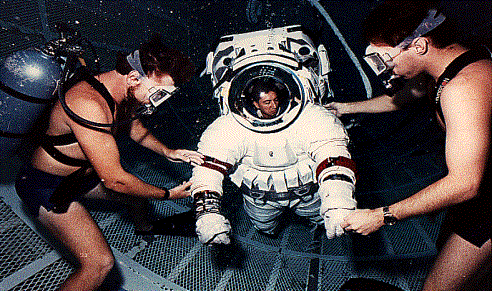
The successful completion of NASA in-space missions begins with
diver-assisted pool training
Acknowledgement
The author extends his thanks to the dedicated divers of WETF for sharing
with him their unique diving operation. He also extends his appreciation to the
administrative staff of the Johnson Space Flight Center for their cooperation in
all aspects of the preparation of this article.
Photo Credits:
All underwater photos are official NASA photographs used with their permission.
This article is now deposited in the Official NASA historical archives.
Go To: Home About "Harris" Articles Slides War Stories Editorials Links Fini
About The Author:
Larry "Harris" Taylor, Ph.D. is a biochemist and Diving Safety
Coordinator at the University of Michigan. He has authored more than 200 scuba
related articles. His personal dive library (See Alert Diver, Mar/Apr, 1997, p.
54) is considered one of the best recreational sources of information In North
America.
All rights reserved.
Use of these articles for personal or organizational profit is specifically denied.
These articles may be used for not-for-profit diving education